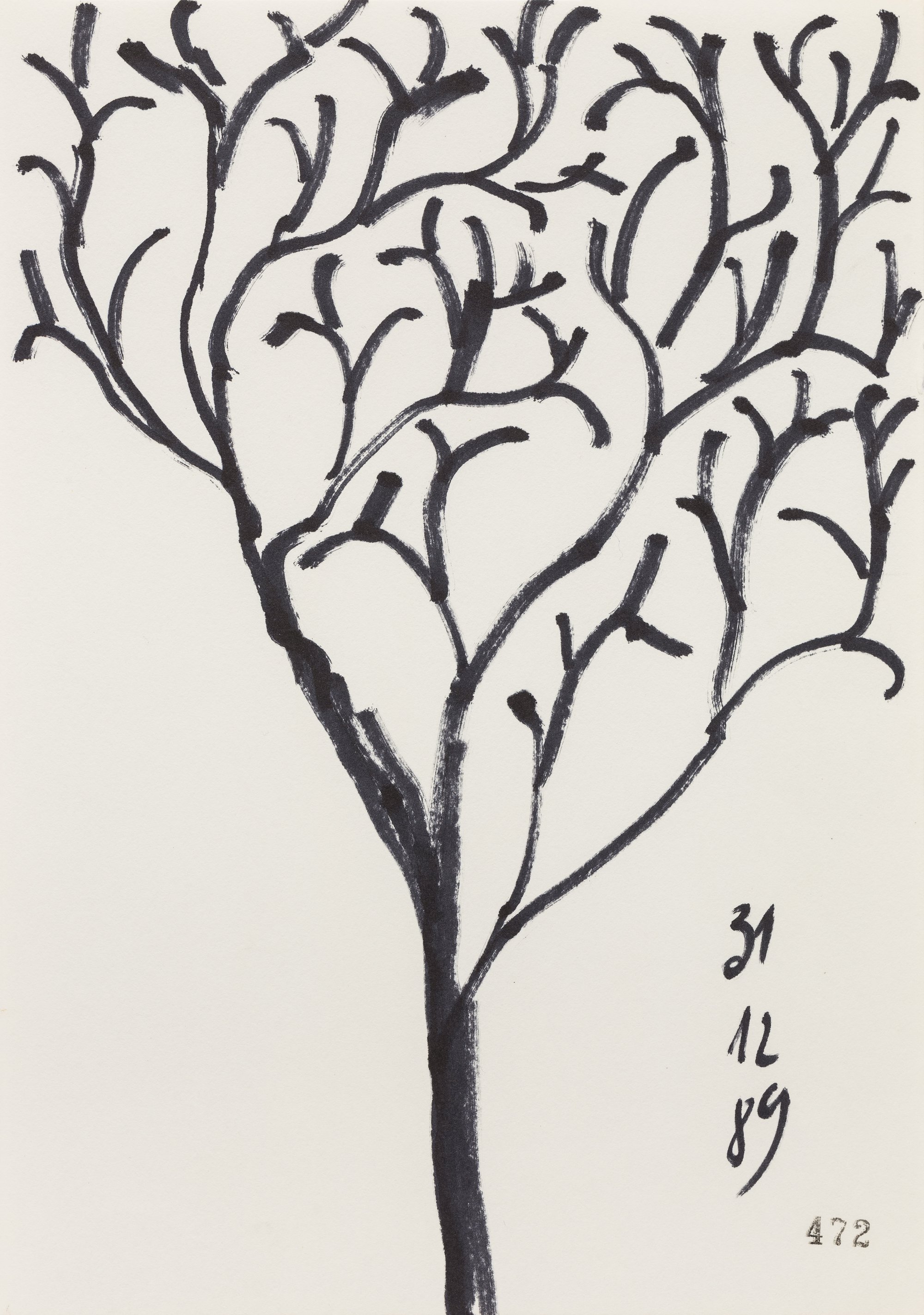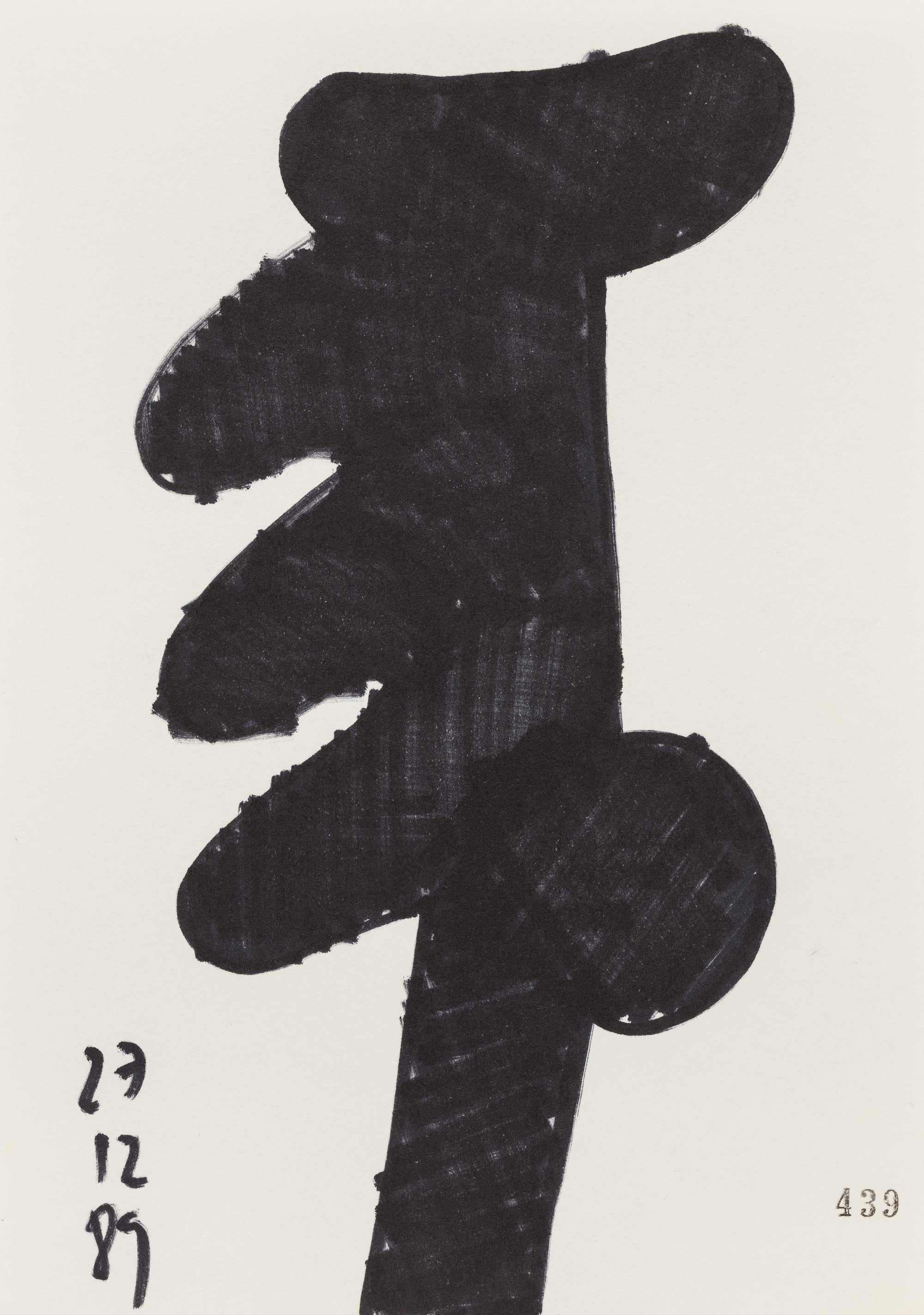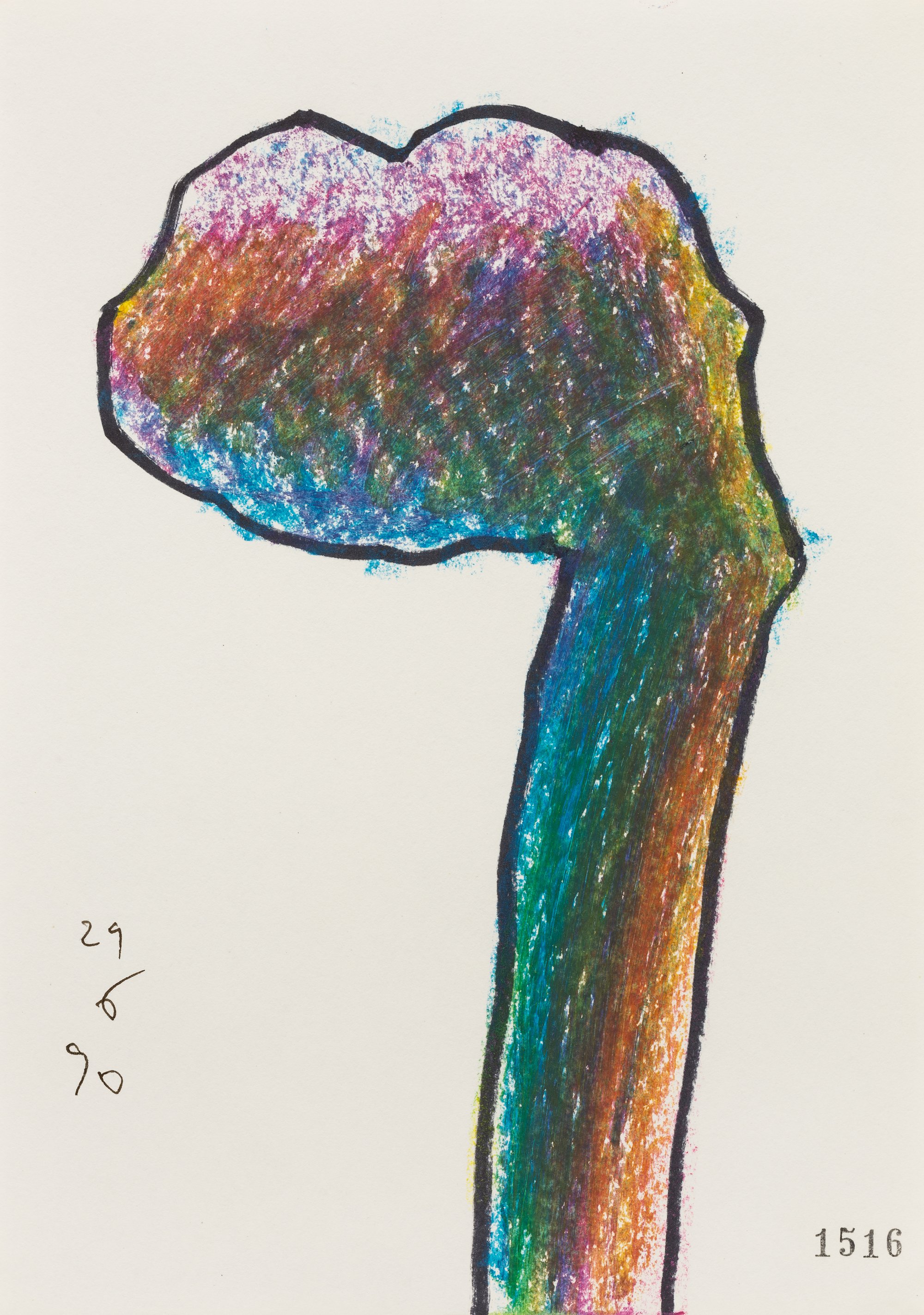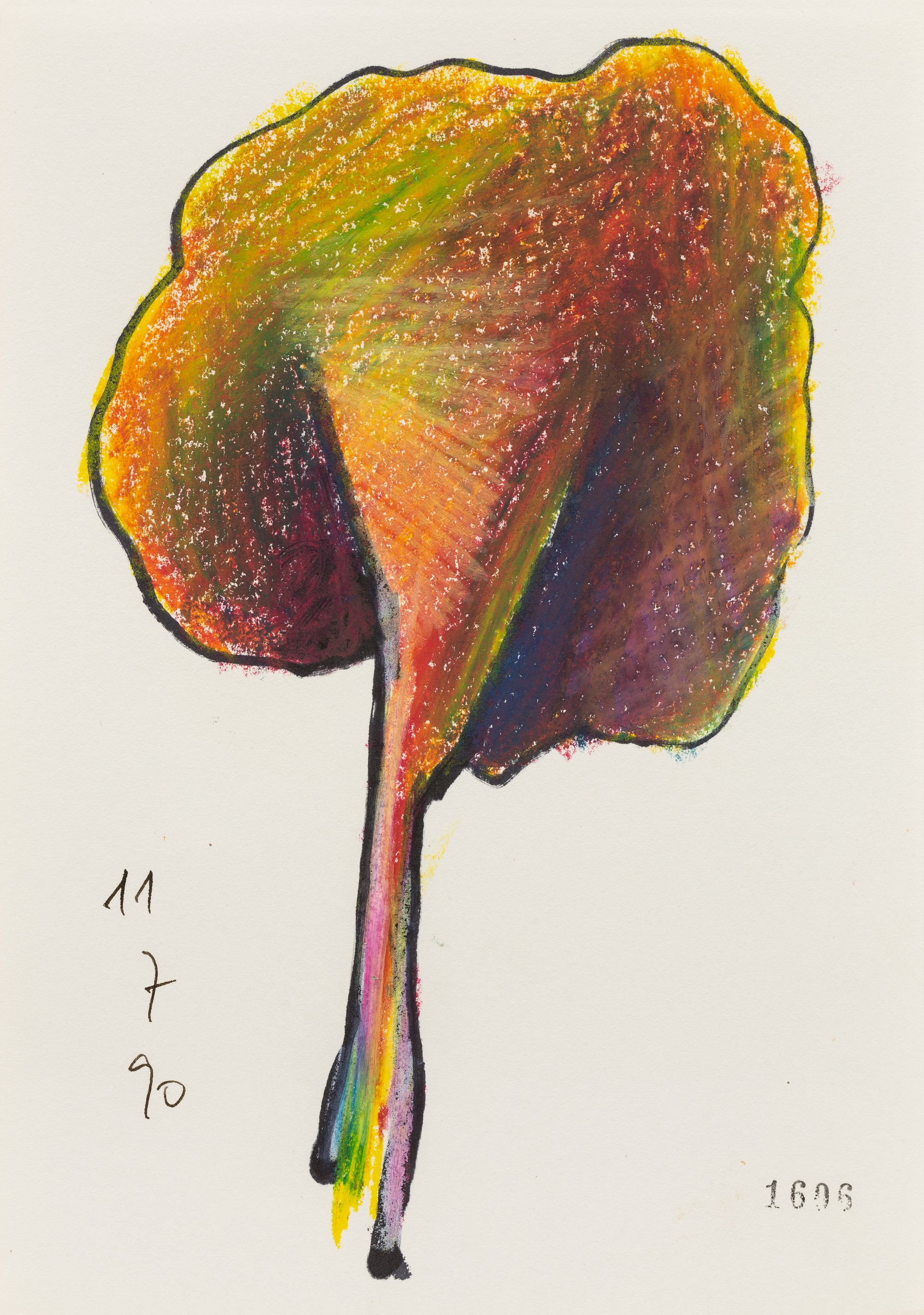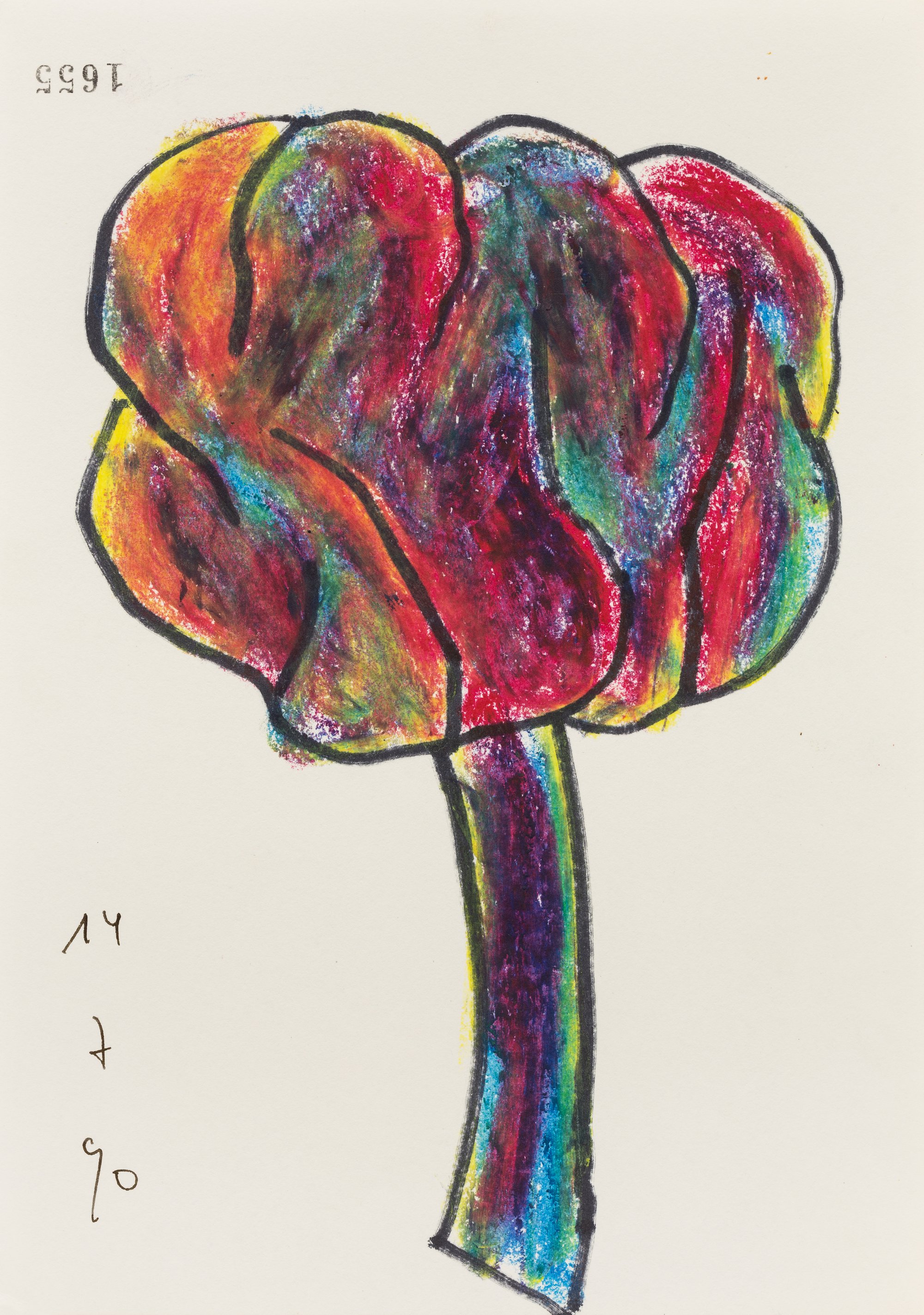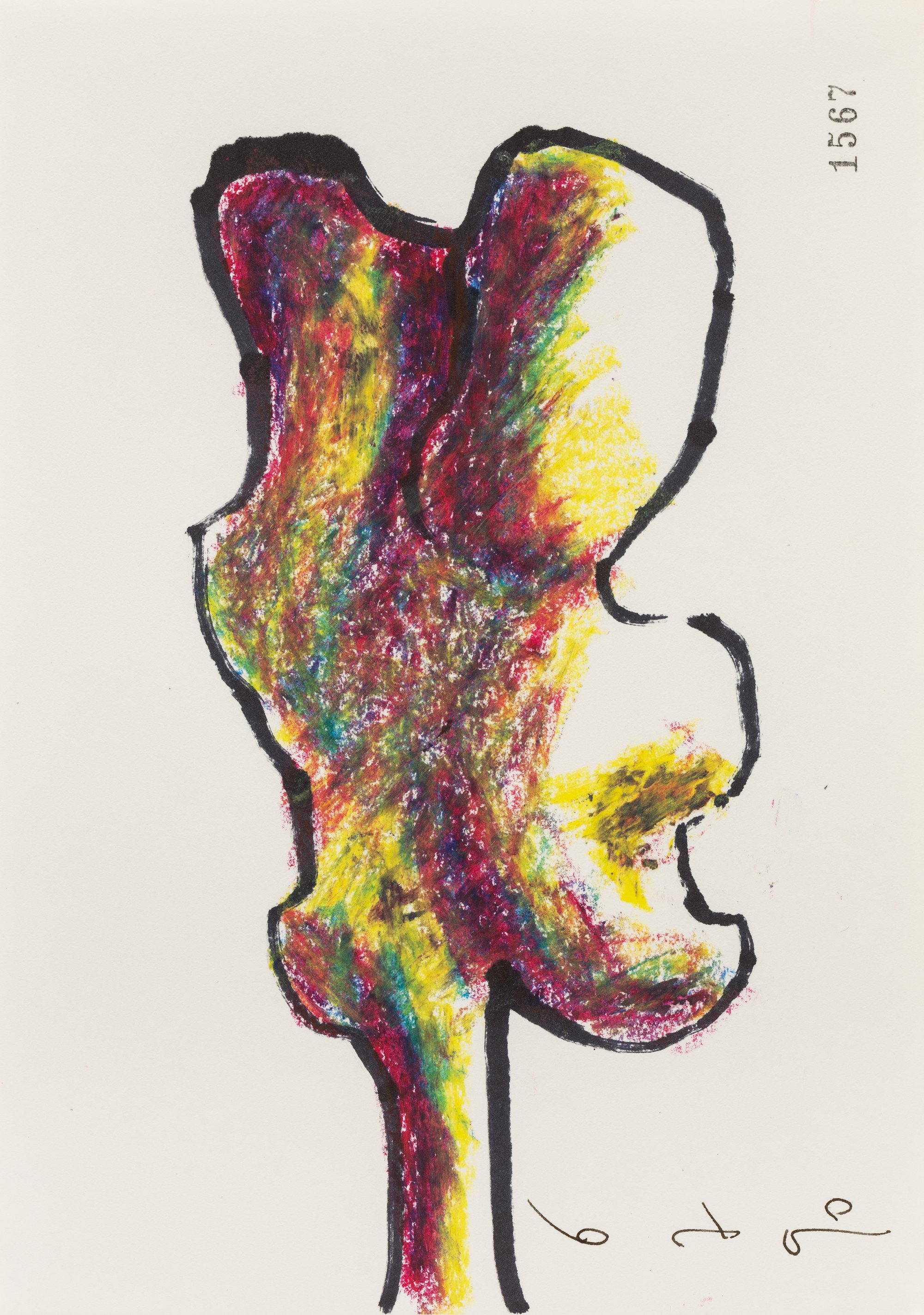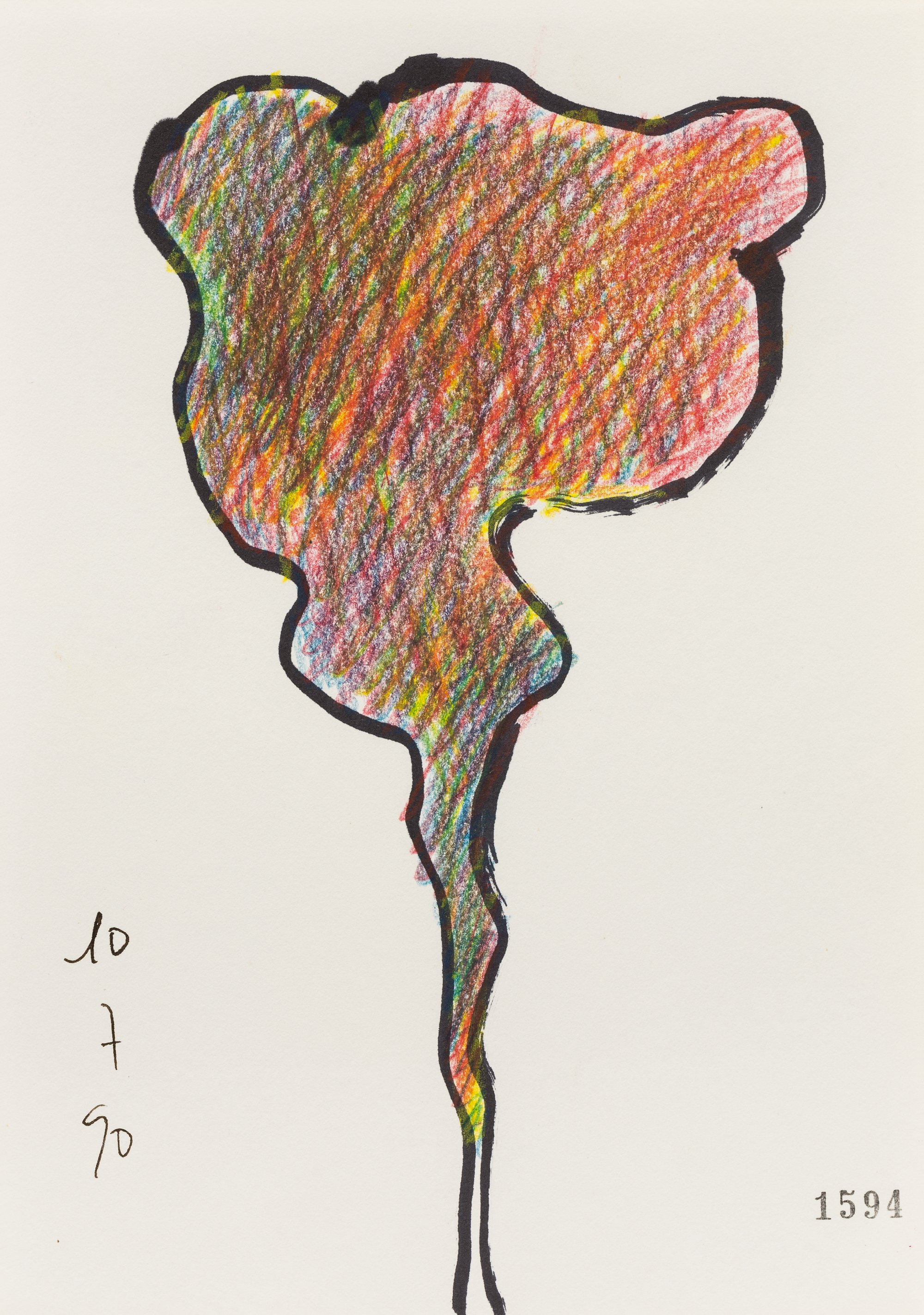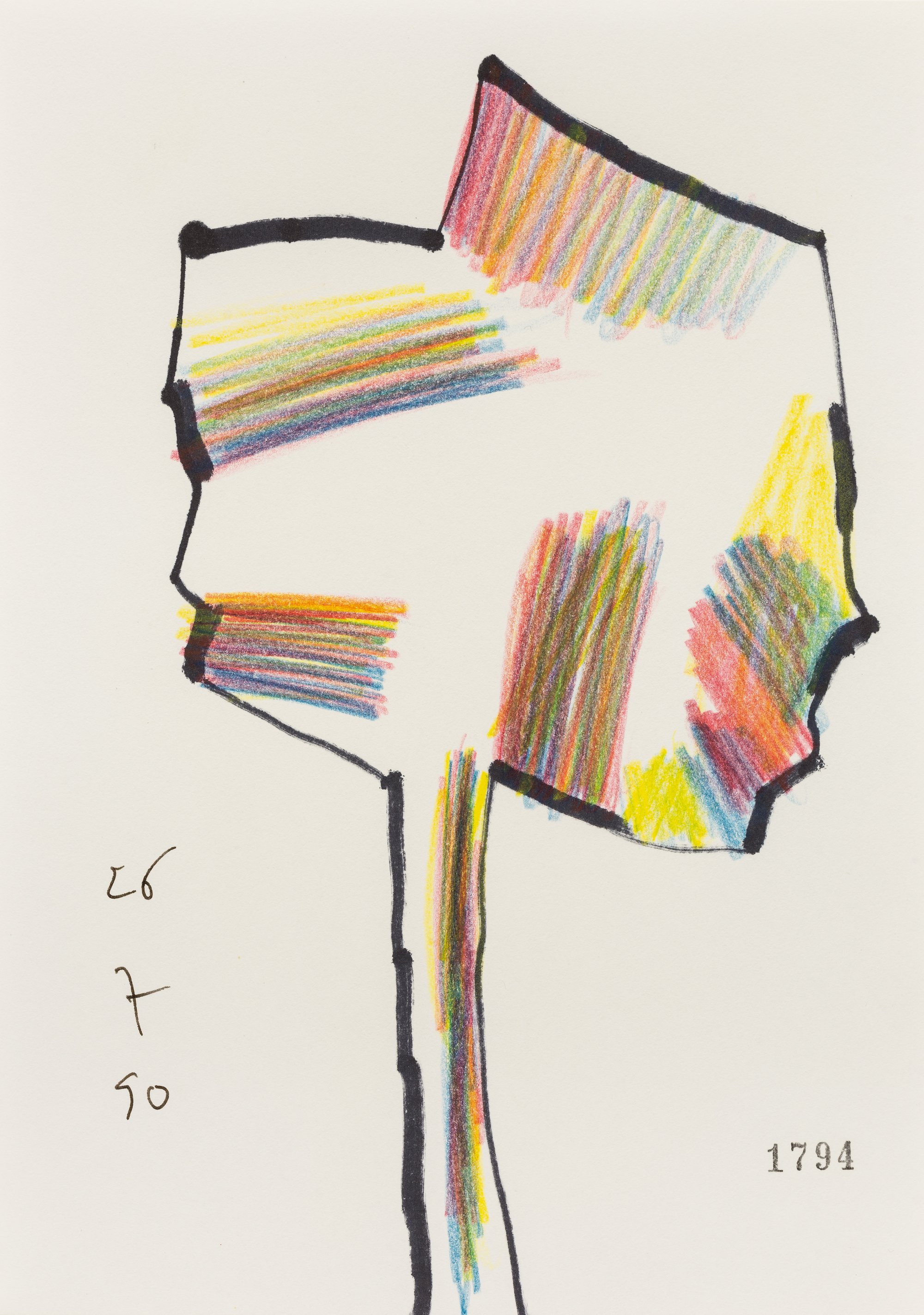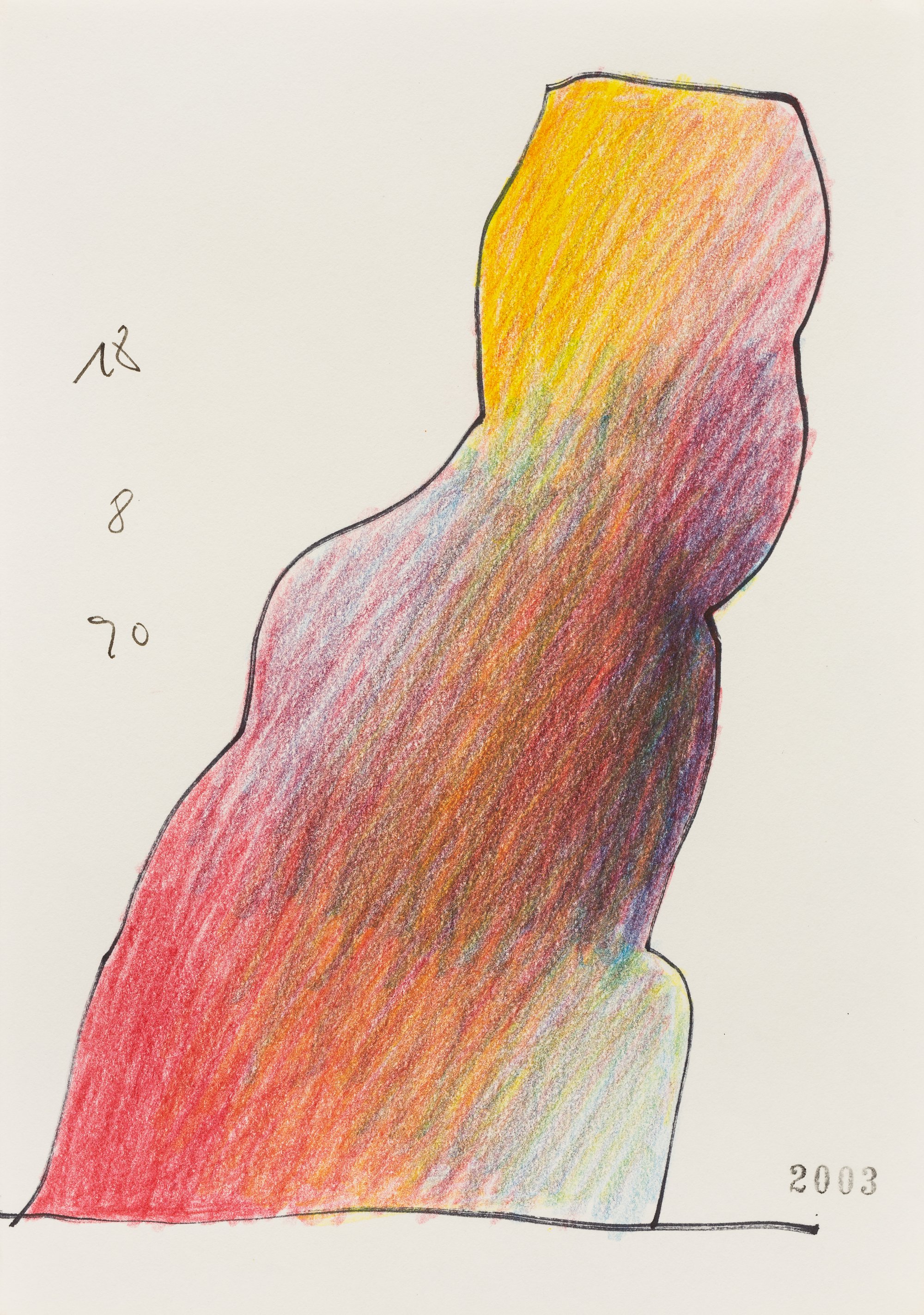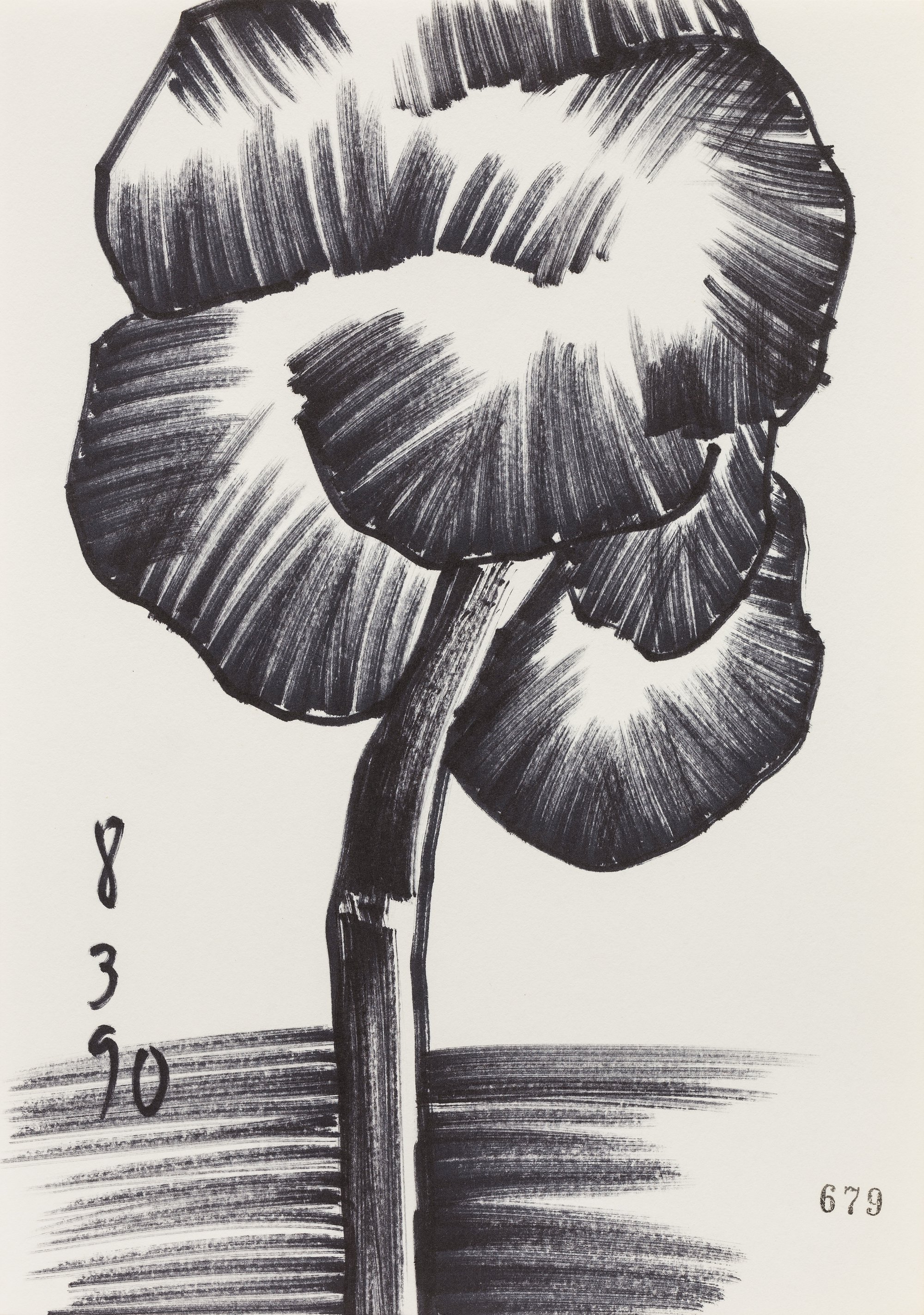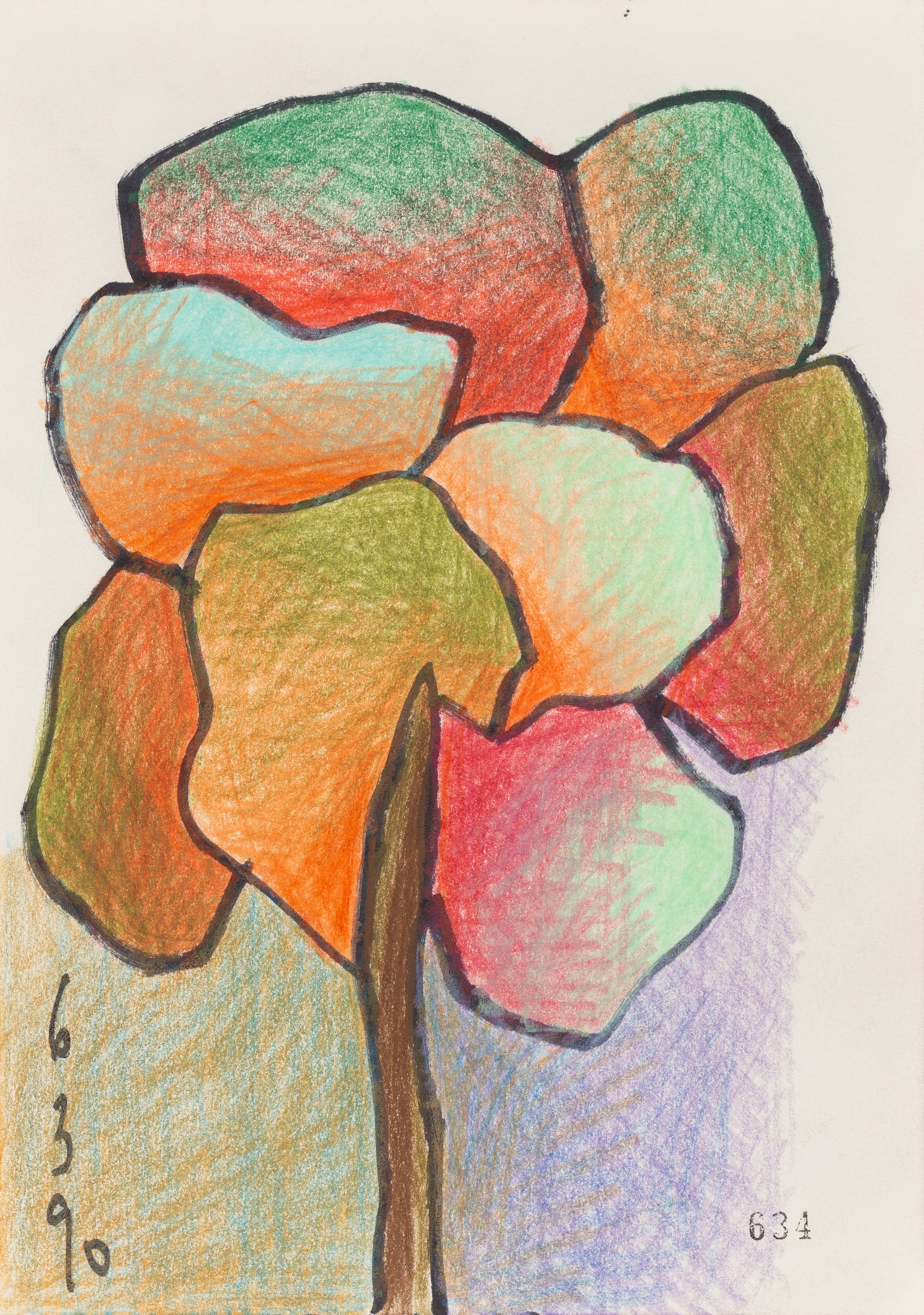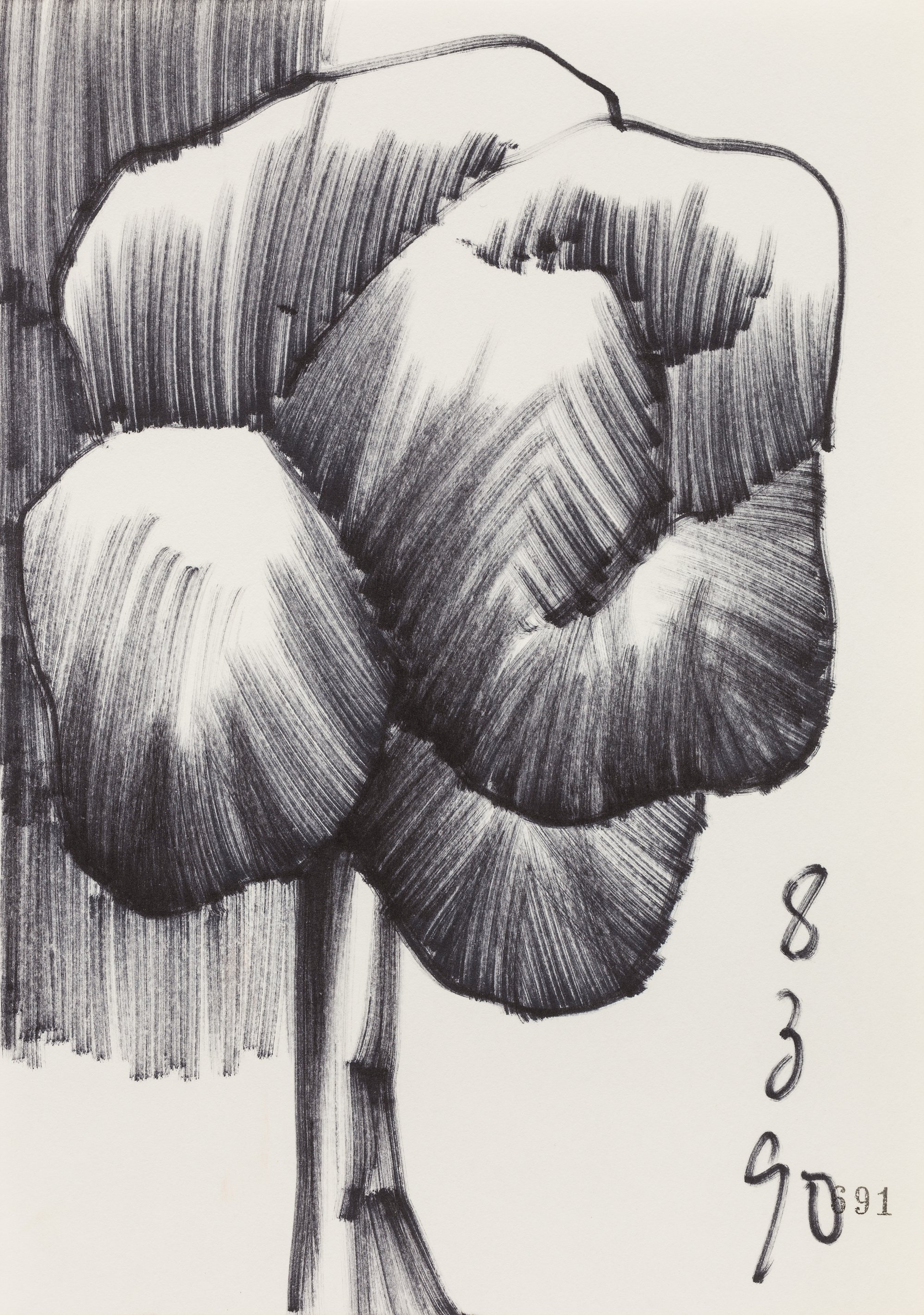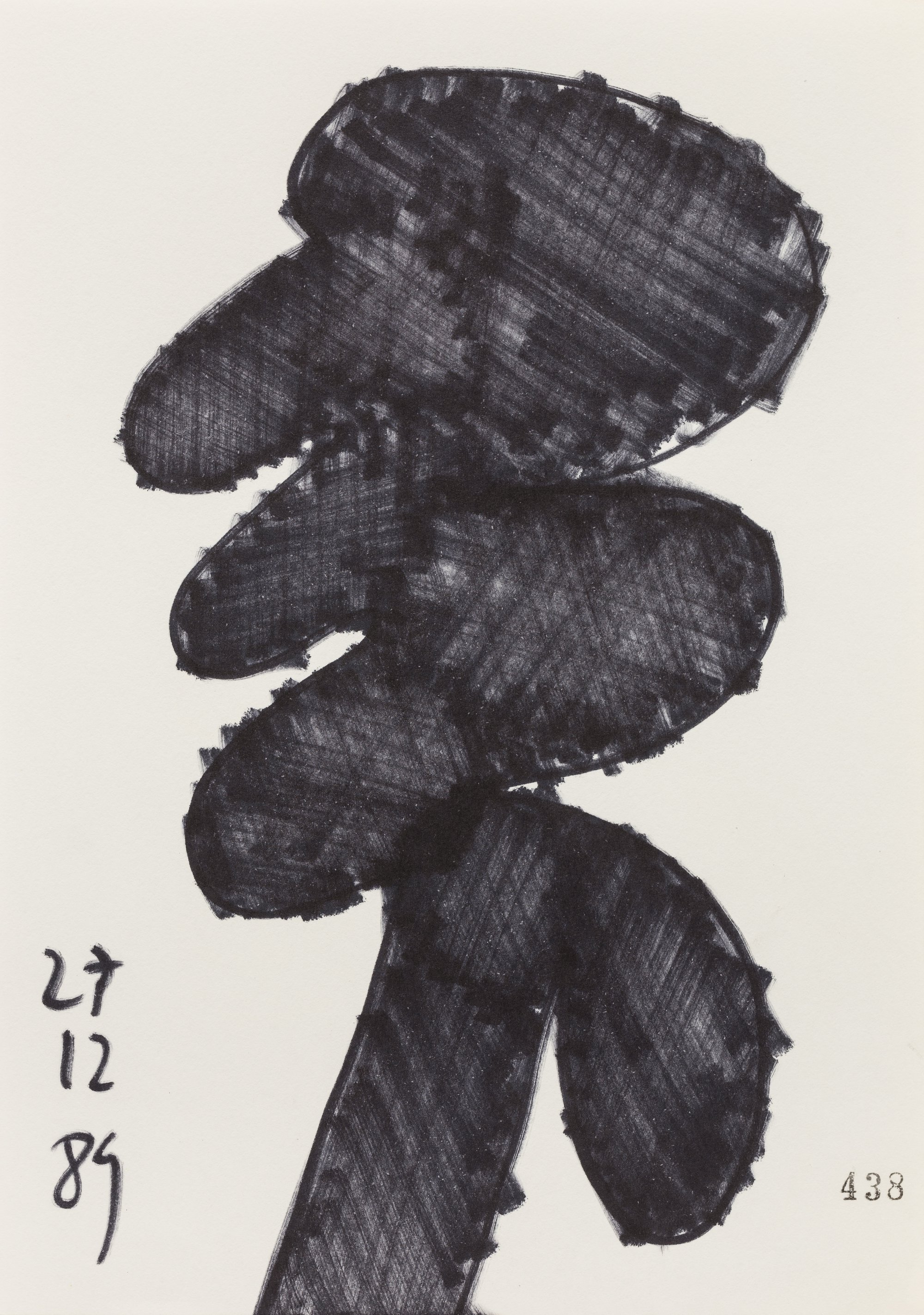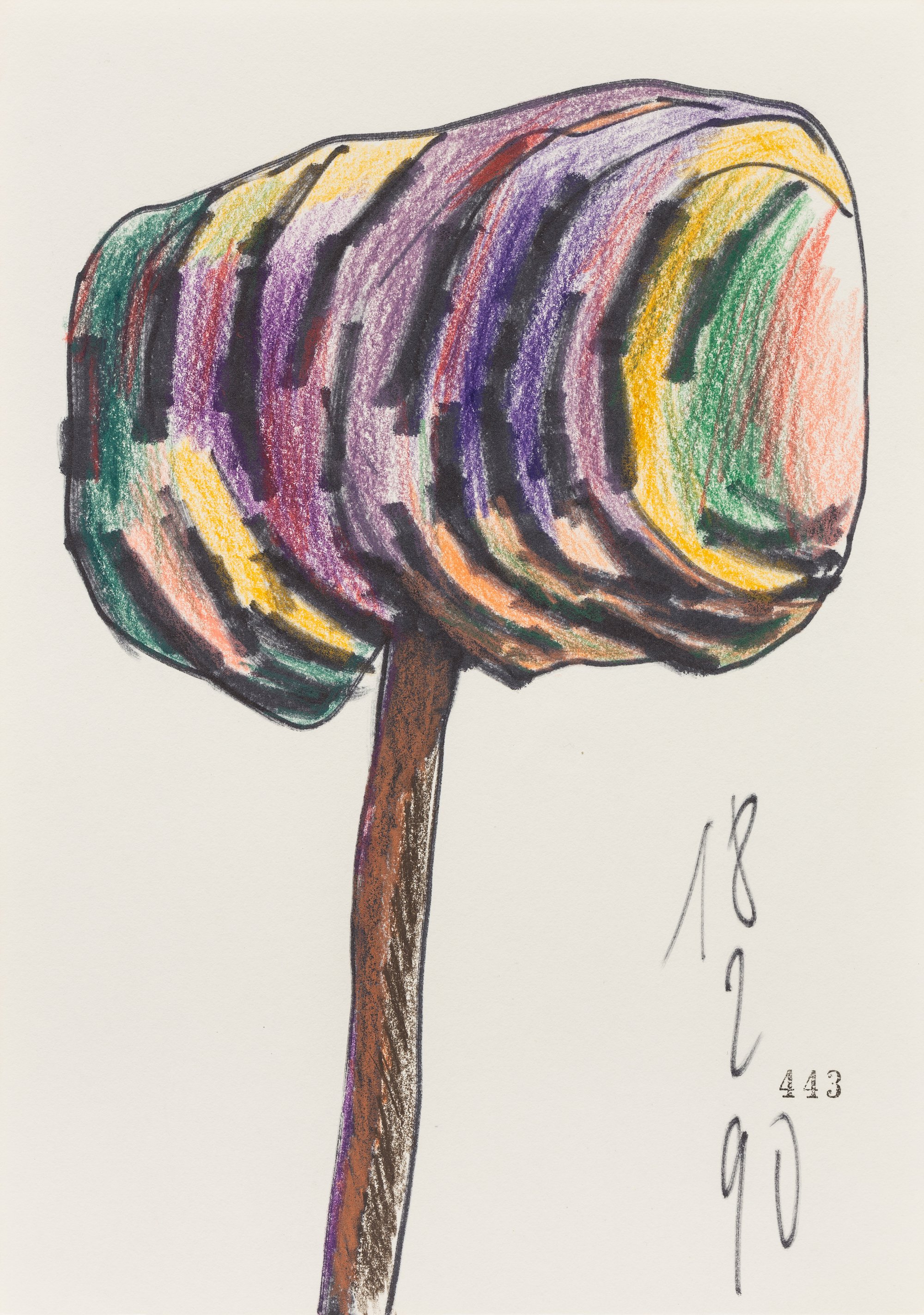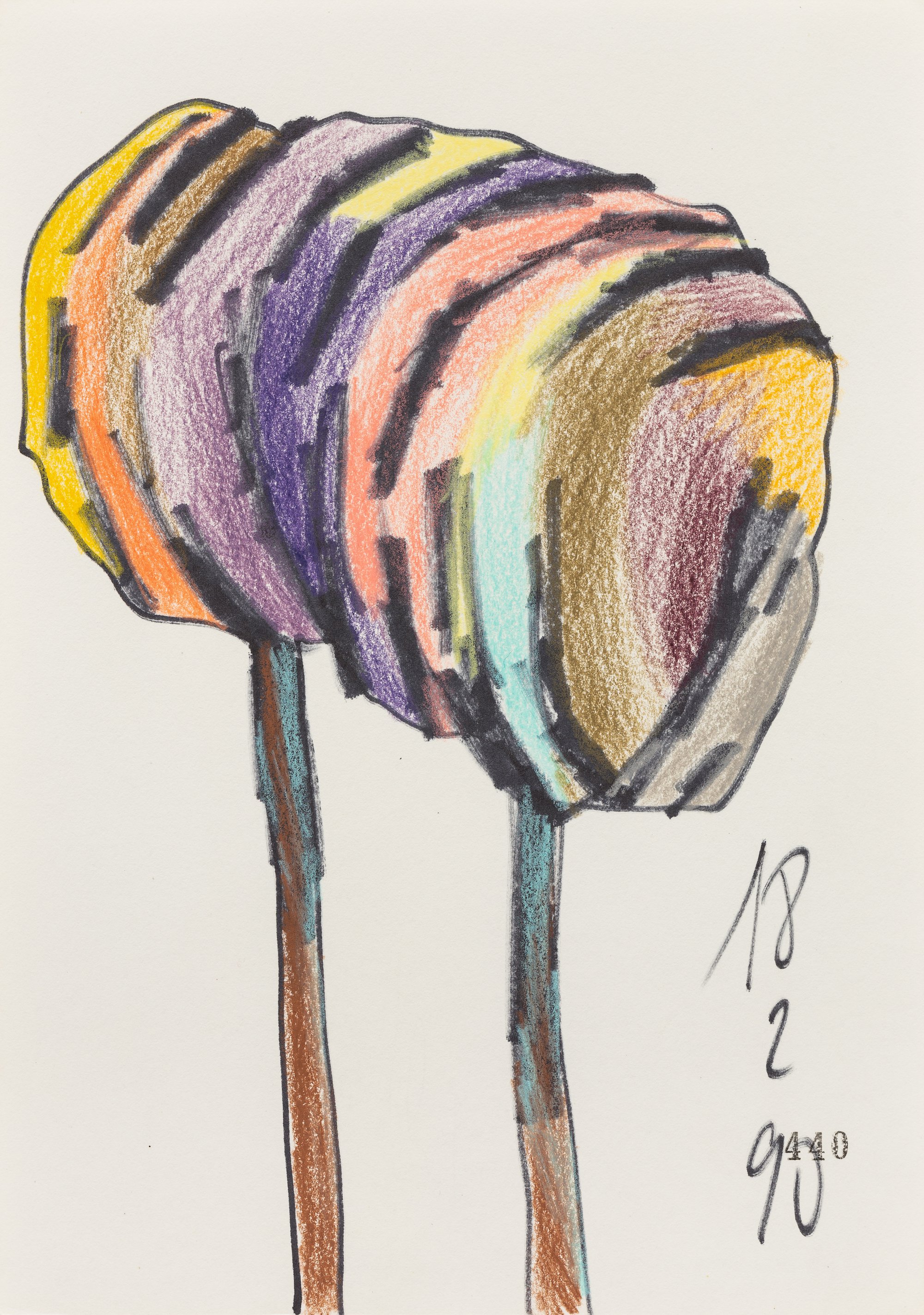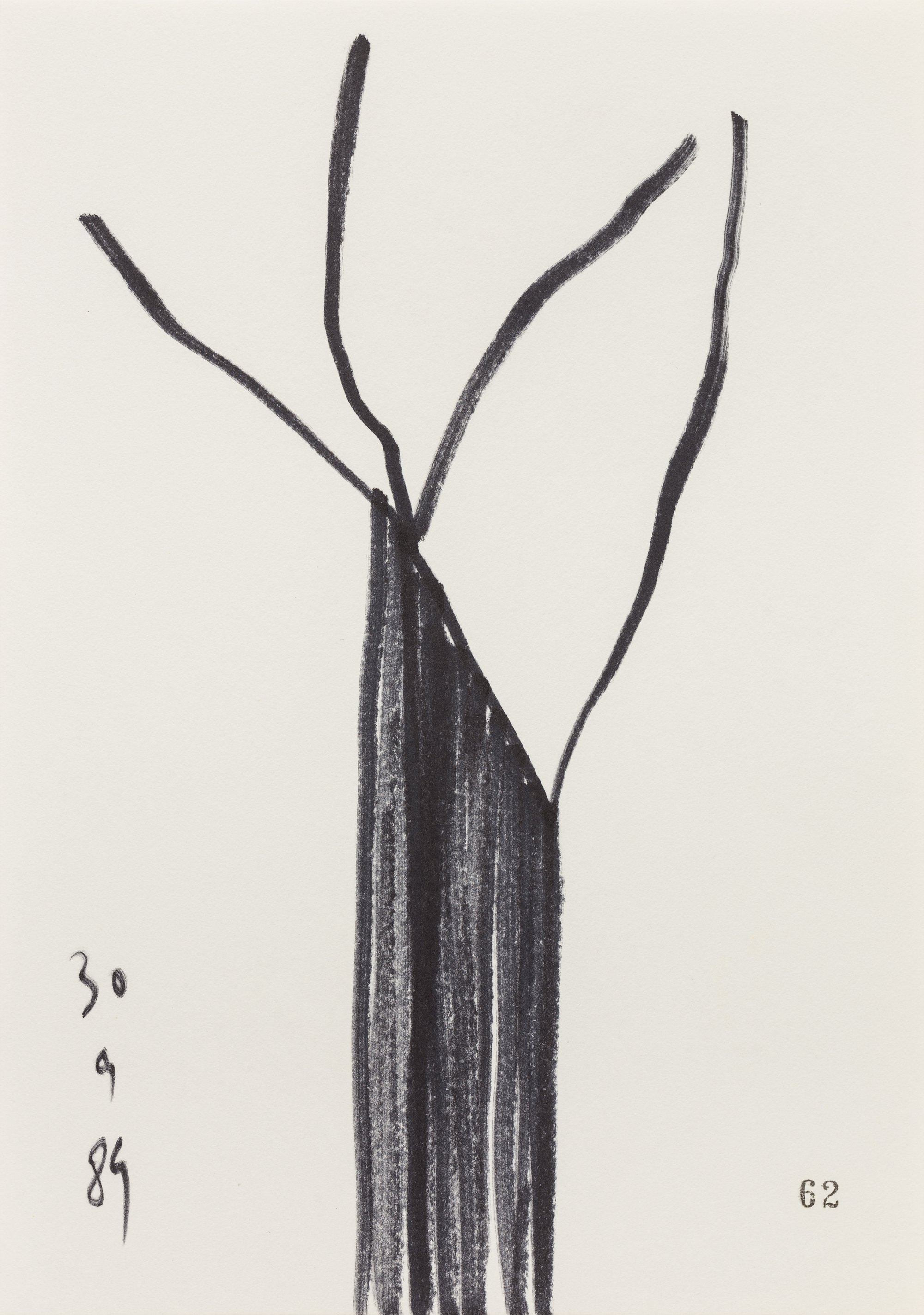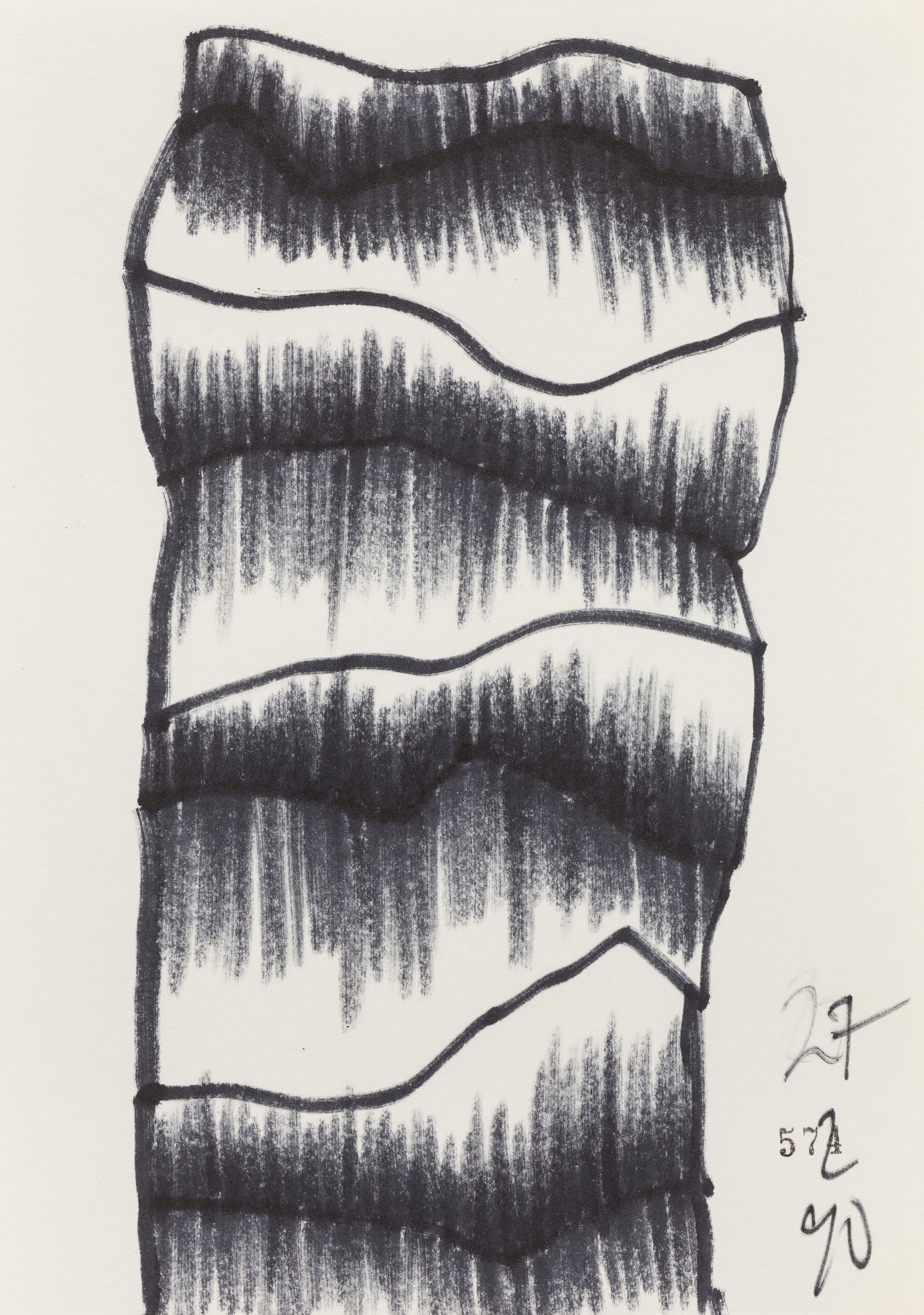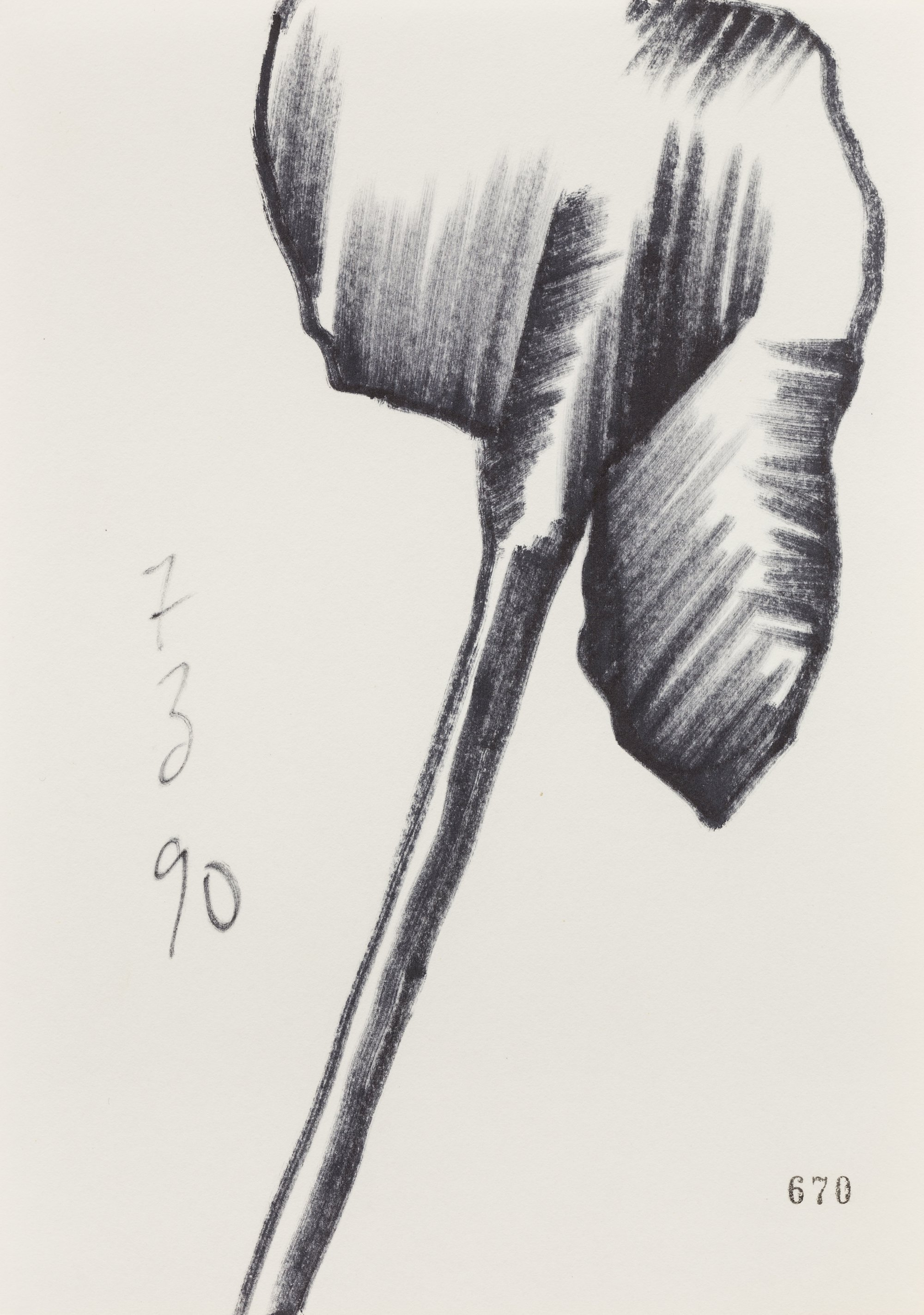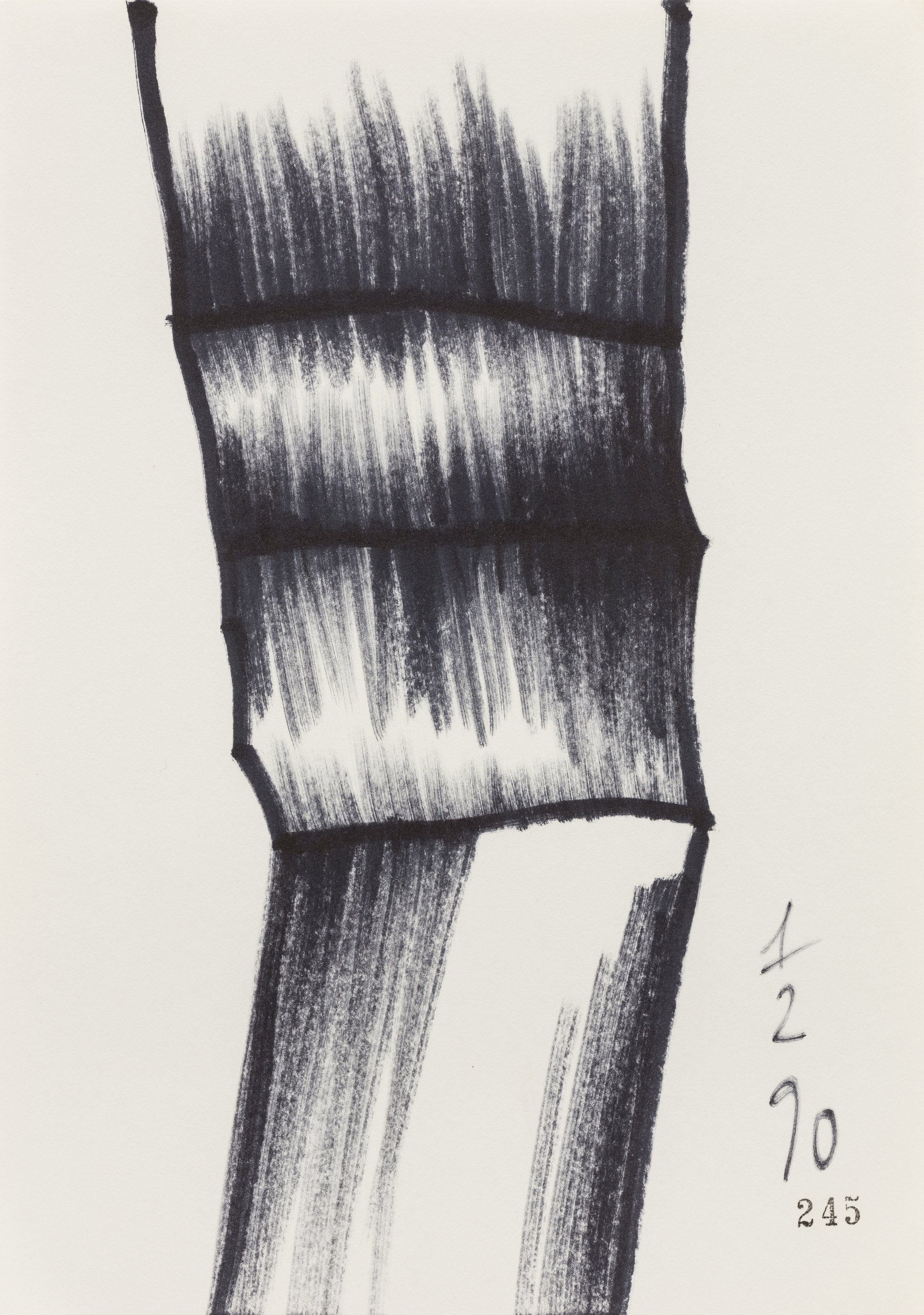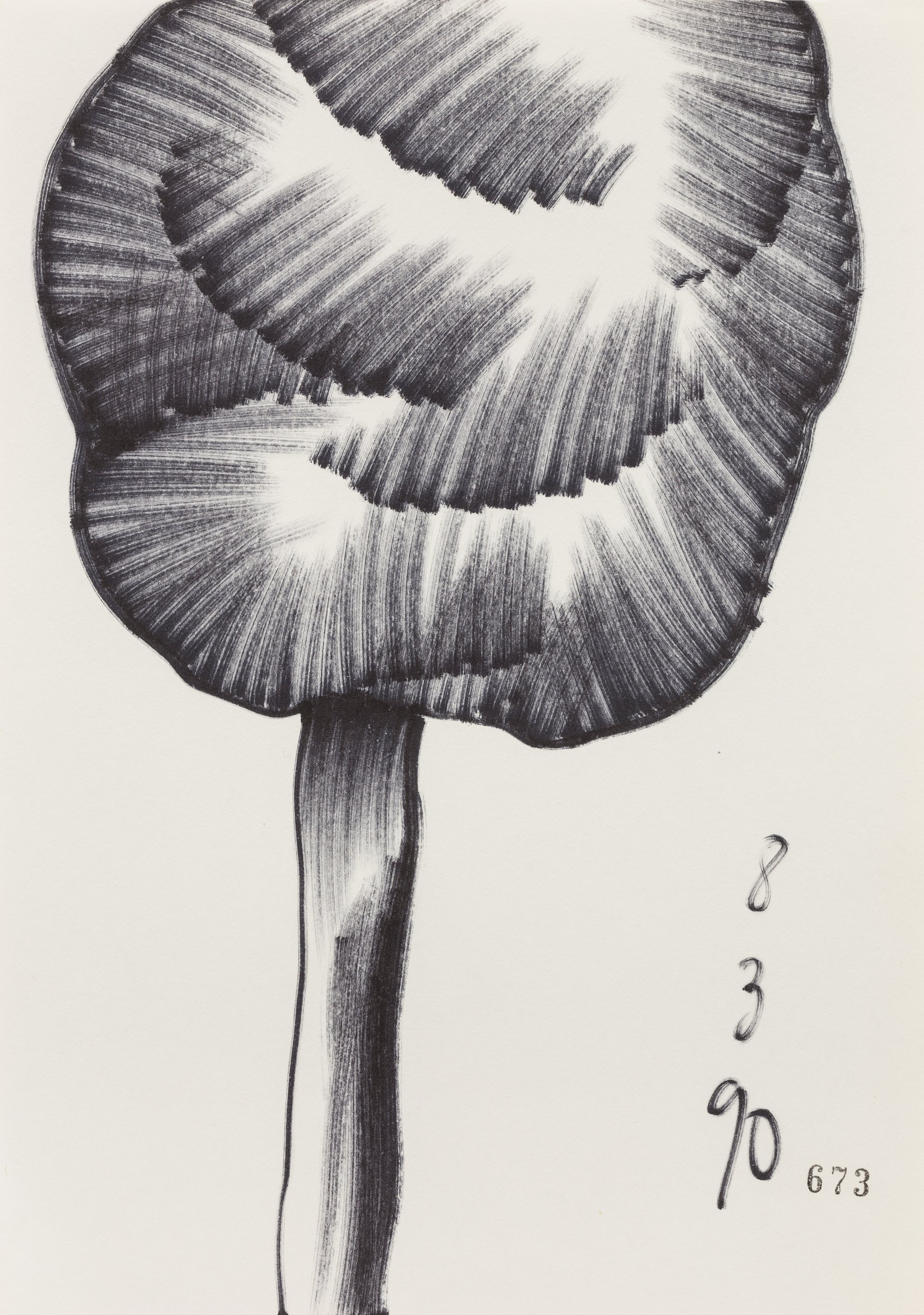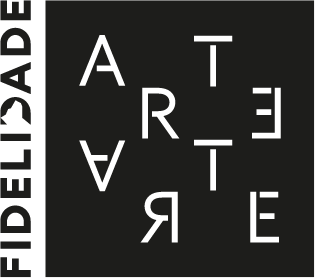Ângelo de Sousa began drawing figures that resembled trees in 1958, at the age of twenty. He drew them all his life, more or less constantly, more or less intensely, and even said in an interview that they were the first relevant pieces he did as an artist. He called them trees – not as one would give a name, but as one would give a nickname.* That is to say, he called them ‘trees’ instead of calling them trees. This distinction – practically imperceptible in speech – reveals a great deal about the artist’s practice. Instead of seeking the archetypal stronghold of a tree – its essence, the common denominator of all trees – what seems to have interested Ângelo de Sousa was precisely the opposite: exploring the margins of the formal territory of what can be a tree: testing the limits of the relationship between the latter and a series of forms that ‘resemble’ it, understanding how far one can go without losing the invisible link between a representation and an idea.
Bruno Marchand
+ Keep ReadingWhat makes a name a nickname is its metonymical nature, the capacity it has to suggest that one part of a thing can be used to signify the whole. It is, therefore, a strategy of reduction, and reduction was something Ângelo de Sousa fought for throughout his career. As the artist himself declared, he was interested in ‘maximum effects with minimum resources, maximum effectiveness with minimum effort, and maximum presence with minimum fuss’. The drawings presented in this exhibition bear witness to the encounter between these two impulses, metonymical and minimalist. The minimalist impulse gives us the tendency towards economy of means and towards representative objectivity – towards the drawing being restricted to the presentation of a single, isolated body, free of adornments or articulations with other elements. The metonymical impulse results in numerous approaches to what a ‘tree’ can be, all the variations of a series that develops as a centrifugal rather than a centripetal force.
Exploring the margins is a way of celebrating diversity. It is also a way of saying that one does not seek – perhaps, even, that one does not believe in – the essentialist version of things. Margins are, of course, zones of contact, of miscegenation, of fluidity and of possibility. They are spaces where we are obliged to negotiate the limits of our own porosity, of how ready we are to review the boundaries of our categories. The works selected for this exhibition allow us to accompany the movement Ângelo de Sousa described between the trees of the late 1950s – skilful representations of this vegetable element, some of them very detailed – and the ‘trees’ of the turn of the century – lumpy masses, like nodular roots or like tubers rendered vertical on A5 paper, drawn unrealistically with the angular tip of a marker pen. In between, a multitude of deviations, variations and alternatives that, together, prefigure the large map of the power of the ‘tree’ in the eyes of the artist.
This is not a figure of speech: Ângelo de Sousa really did see ‘trees’ when he looked at the paper. Of the thousands of drawings he did within this theme, he only kept those that he thought ‘worked’. Some of these he would use as the basis for larger drawings or even paintings; others would become a record of the marginal cartography that he attempted with every new session. All of them, without exception, are the fruit of a way of doing that, in order to ‘work’, needed to force the hand to follow what the imagination saw hovering, like a ghost, on the surface of the paper. Without diversions, without digressions. ‘When it didn’t follow it, it didn’t turn out right.’
When it followed it, a kind of suspension of artistic intentionality materialised. This brings to mind another complicated expression, coined by Marcel Duchamp: ‘art coefficient’. For the French artist, the art coefficient was the difference between what the artist wanted to do and what he actually did – the ‘something’ that is beyond the artist’s control, but still their responsibility. It is not chance, nor is it accident – it is the shifting of a gesture that was meant to do one thing but ended up doing another. Following a form that one sees hover over the paper, suspending all interference of will, of artistic licence, is something that is only possible through a dual training: the training of the hand to follow the imagination and of the imagination to invent the right form. The drawings presented here are the fruit of the exercise that Ângelo de Sousa did throughout his life; of the constant search for the ability to make the art coefficient equal to zero.
* - All the quotes in this text are taken from the interview with Ângelo de Sousa conducted by Nuno Faria and included in the catalogue Transcrições e Orquestrações - desenhos de Ângelo de Sousa, Lisbon: CAM, 2003.
- ResumeBetween 1995 and 2017, Jorge Silva Melo crosses his dimension as a chronicler with his passion for cinema and starts a series of portraits that shows the works of various plastic artists. One of them was Ângelo de Sousa. Ângelo De Sousa: Tudo O Que Sou Capaz began shooting in 2007 and premiered in 2010. According to the director himself, this is a "portrait of a man who wants to be stubbornly simple, an artist who reduced his work to the three primary colors and to black and white, constantly inventing new forms or altering the forms in supports that dynamize them." A collaborative work, such was the proximity to the artist.
ÂNGELO DE SOUSA
Ângelo de Sousa (Lourenço Marques, MZ, 1938 – Porto, PT, 2011) lived and worked in Porto since 1955.
Painting, photography, film, sculpture, drawing and installation shaped his artistic discourse, supported by a practice that always valued the experimental character. Seriality, repetition and the economy of formal resources are fundamental in his trajectory, leading to the creation of works that seek to obtain "the maximum effect with the minimum of resources, the maximum efficiency with the minimum effort, and the maximum presence with a minimum of screaming”.
He held his first exhibition in 1959, at Galeria Divulgação, in Porto, alongside Almada Negreiros. In 1977, he was one of the artists selected by Ernesto de Sousa to participate in Alternativa Zero, an important exhibition at the time which is still an historic reference. In 1993, Serralves Foundation organized an anthological show of his painting and drawing work and, in 2001, of his work in photography and cinema. In 2008, Ângelo de Sousa represented Portugal at the 11th International Architecture Exhibition at the Venice Biennale, in partnership with the architect Eduardo Souto Moura.
In 1975, he was awarded the International Prize (ex aequo) at the 13th Bienal de São Paulo, in 1986, with the Painting Prize at the 3rd Plastic Arts Exhibition of the Calouste Gulbenkian Foundation, and, in 2000, he received the EDP Grand Prize.
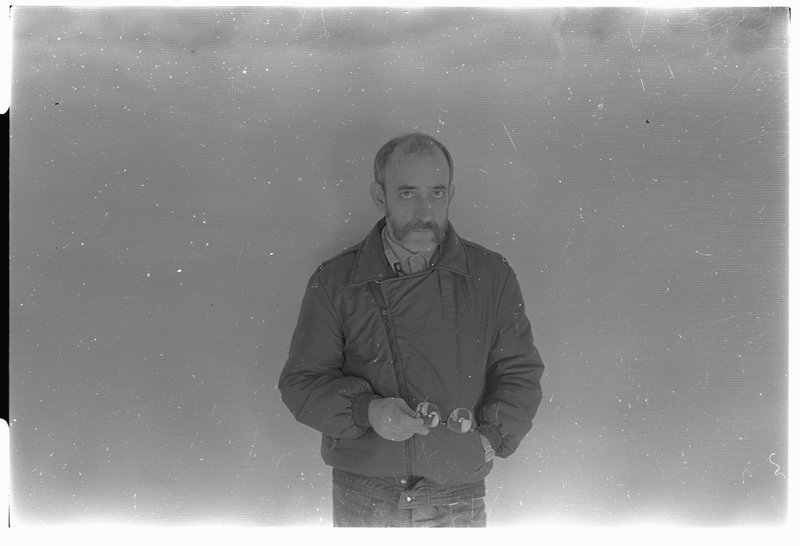
CHAIN REACTION
This exhibition is the ninth and last moment of the Chain Reaction cycle, a collaboration between Fidelidade Arte and Culturgest, which involved the participating artists in choosing the artist who succeeded them. Curated by Delfim Sardo (2019–2020) and Bruno Marchand (2020–2022), the cycle implied an adaptation of the exhibition project to the characteristics of the spaces that host it, namely, Fidelidade Arte, in Chiado, Lisbon, and Culturgest, in Aliados, Porto.
At the end of each year of the cycle, a book is published with extensive documentation of the three projects presented. The first two volumes are currently available.
+ Keep ReadingThe cycle began in 2019 with a program that, following this logic of succession, had the participation of the following artists:
2019
#1 Ângela Ferreira (Mozambique, 1958)
#2 Jimmie Durham (USA, 1940 – Germany, 2021)
#3 Elisa Strinna (Italy, 1982)
2020
#4 Evan Roth (USA, 1978)
#5 Alicia Kopf (Spain, 1982)
#6 Las Palmas (Portugal)
2021
#7 Rodrigo Hernández (Mexico, 1983)
#8 Silvia Bächli (Switzerland, 1956)
#9 Ângelo de Sousa (Mozambique, 1938 – Portugal, 2011)
Reação em Cadeia
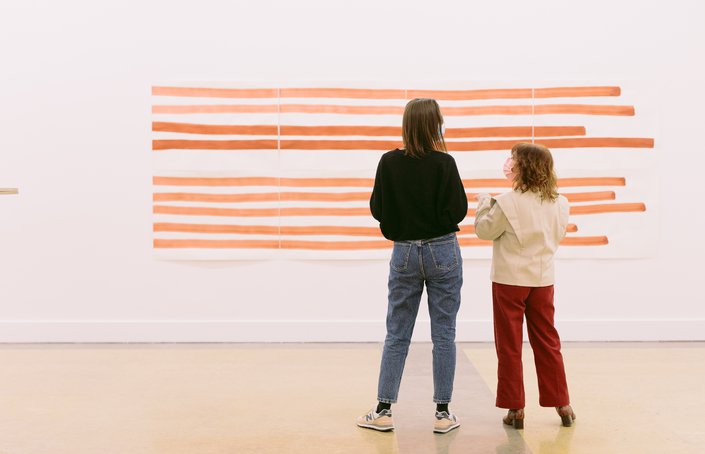
18 Dec 2021 – 6 Mar 2022 SILVIA BÄCHLI Side facing the wind
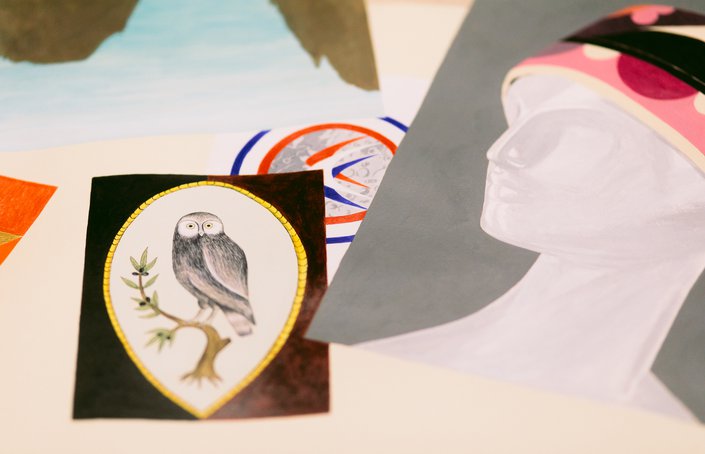
9 Oct – 5 Dec 2021 RODRIGO HERNÁNDEZ Moon Foulard
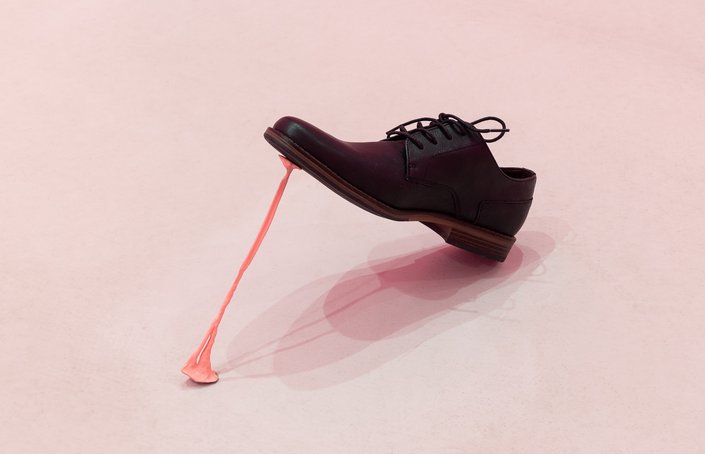
21 May – 5 Sep 2021 Las Palmas Apophenia

7 Apr – 2 May 2021 Alicia Kopf Speculative Intimacy
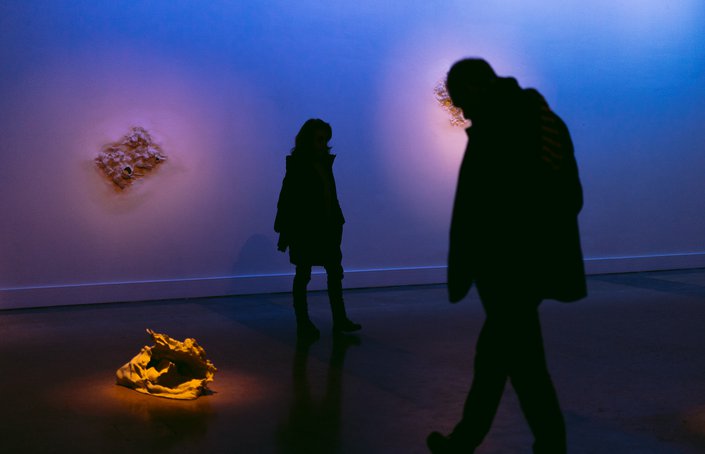
23 May – 30 Aug 2020 Elisa Strinna Blind Sun
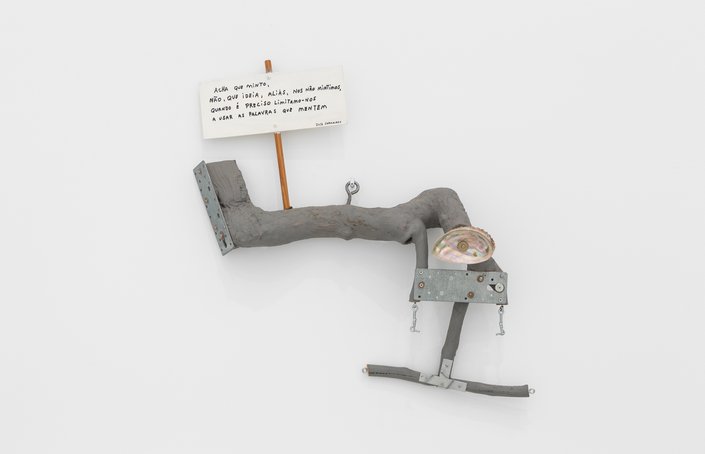
14 Sep 2019 – 5 Jan 2020 Jimmie Durham Do you say I am lying?
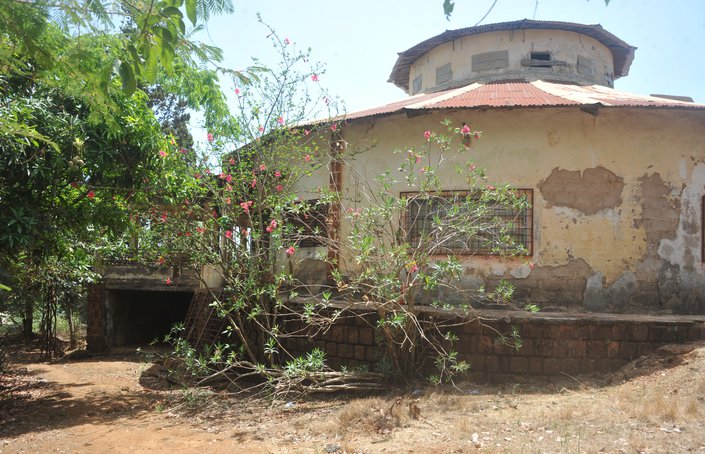
1 Jun – 1 Sep 2019 ÂNGELA FERREIRA DALABA: SOL D’EXIL
FICHA TÉCNICA
EXPOSIÇÃO
CURADORIA
Bruno Marchand
ASSISTENTE DE CURADORIA
Sílvia Gomes
COORDENADOR DE PRODUÇÃO
António Sequeira Lopes
PRODUÇÃO
(CULTURGEST PORTO)
Susana Sameiro
ESTAGIÁRIO
João Reis
PREPARAÇÃO DE OBRAS
Isabel Zarazúa
Renato Ferrão
MONTAGEM
Bruno Fonseca
Renato Ferrão
AGRADECIMENTOS
Miguel de Sousa
Joana Caldeira
Carla Garcia
Mário Valente
MICROSITE
EDIÇÃO
Inês Bernardo
REVISÃO DE CONTEÚDOS
Catarina Medina
DESIGN E WEBSITE
Studio Macedo Cannatà & Queo
